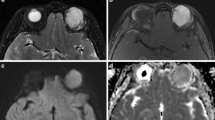Abstract
Purpose
Preoperative assessment of extraocular muscle invasion is essential for therapeutic strategies and prognostic evaluation. The aim of this study was to assess the diagnostic accuracy of MRI for evaluation of extraocular muscle (EM) invasion by malignant sinonasal tumors.
Materials and methods
Consecutively, 76 patients of sinonasal malignant tumors with orbital invasion were included in the present study. Preoperative MRI imaging features were analyzed by two radiologists independently. The diagnostic performances of MR imaging features for detecting EM involvement were evaluated by comparing imaging findings to histopathology data.
Results
A total of 31 extraocular muscles were involved by sinonasal malignant tumors in 22 patients, including 10 medial rectus muscles (32.2%), 10 inferior rectus muscles (32.2%), 9 superior oblique muscles (29.1%), and 2 external rectus muscles (6.5%). The EM involved by sinonasal malignant tumors usually showed relatively high signal intensity on T2-weighted images, indistinguishable from the tumor, nodular enlargement and abnormal enhancement (p = 0.001, < 0.001, < 0.001 and < 0.001, respectively). Using a combination of EM abnormal enhancement and indistinguishable from the tumor in multivariate logistic regression analysis, sensitivity, specificity, positive predictive value, negative predictive value and diagnostic accuracy for detecting orbital EM invasion by sinonasal tumors were 93.5, 85.2, 76.3, 96.3 and 88%, respectively.
Conclusion
MRI imaging features show high diagnostic performance for the diagnosis of extraocular muscle invasion by malignant sinonasal tumors.




Similar content being viewed by others
Availability of data and materials
The datasets generated and analyzed during the current study are available from the corresponding author on reasonable request.
References
Castelnuovo P, Lambertoni A, Sileo G et al (2021) Critical review of multidisciplinary approaches for managing sinonasal tumors with orbital involvement. Acta Otorhinolaryngol Ital 41(1):S76–S89. https://doi.org/10.14639/0392-100X-suppl.1-41-2021-08
Neel GS, Nagel TH, Hoxworth JM, Lal D (2017) Management of orbital involvement in sinonasal and ventral skull base malignancies. Otolaryngol Clin North Am 50(2):347–364. https://doi.org/10.1016/j.otc.2016.12.010
Carrillo JF, Güemes A, Ramírez-Ortega MC, Oñate-Ocaña LF (2005) Prognostic factors in maxillary sinus and nasal cavity carcinoma. Eur J Surg Oncol 31(10):1206–1212. https://doi.org/10.1016/j.ejso.2005.04.001
Ganly I, Patel SG, Singh B et al (2005) Craniofacial resection for malignant paranasal sinus tumors: report of an International Collaborative Study. Head Neck 27(7):575–584. https://doi.org/10.1002/hed.20165
Amin MB, Greene FL, Edge SB, et al (2017) The Eighth Edition AJCC cancer staging manual: continuing to build a bridge from a population-based to a more “personalized” approach to cancer staging. CA Cancer J Clin 67(2):93–99. https://doi.org/10.3322/caac.21388
Edge SB, Byrd DR, Compton CC, Fritz AG, Greene FL, Trotti A (eds) (2010) AJCC cancer staging manual, 7th edn. Springer, New York
Lisan Q, Kolb F, Temam S, Tao Y, Janot F, Moya-Plana A (2016) Management of orbital invasion in sinonasal malignancies. Head Neck 38(11):1650–1656. https://doi.org/10.1002/hed.24490
Muscatello L, Fortunato S, Seccia V, Marchetti M, Lenzi R (2016) The implications of orbital invasion in sinonasal tract malignancies. Orbit 35(5):278–284. https://doi.org/10.1080/01676830.2016.1193532
Mody MD, Saba NF (2020) Multimodal therapy for sinonasal malignancies: updates and review of current treatment. Curr Treat Options Oncol 21(1):4. https://doi.org/10.1007/s11864-019-0696-4
Vartanian JG, Toledo RN, Bueno T, Kowalski LP (2018) Orbital exenteration for sinonasal malignancies: indications, rehabilitation and oncologic outcomes. Curr Opin Otolaryngol Head Neck Surg 26(2):122–126. https://doi.org/10.1097/MOO.0000000000000441
Salfrant M, Garcia GCTE, Guichard JP et al (2021) Imaging of skull base and orbital invasion in sinonasal cancer: correlation with histopathology. Cancers (Basel) 13(19):4963. https://doi.org/10.3390/cancers13194963
Meerwein CM, Pazahr S, Soyka MB, Hüllner MW, Holzmann D (2020) Diagnostic accuracy of computed tomography and magnetic resonance imaging compared to surgical exploration for anterior skull base and medial orbital wall infiltration in advanced sinonasal tumors. Head Neck 42(8):2002–2012. https://doi.org/10.1002/hed.26129
Kim HJ, Lee TH, Lee HS, Cho KS, Roh HJ (2006) Periorbita: computed tomography and magnetic resonance imaging findings. Am J Rhinol 20(4):371–374. https://doi.org/10.2500/ajr.2006.20.2889
Eisen MD, Yousem DM, Loevner LA, Thaler ER, Bilker WB, Goldberg AN (2000) Preoperative imaging to predict orbital invasion by tumor. Head Neck 22(5):456–462. https://doi.org/10.1002/1097-0347(200008)22:5%3c456::aid-hed3%3e3.0.co;2-n
Patrinely JR, Osborn AG, Anderson RL, Whiting AS (1989) Computed tomographic features of nonthyroid extraocular muscle enlargement. Ophthalmology 96(7):1038–1047. https://doi.org/10.1016/s0161-6420(89)32785-0
Rana K, Juniat V, Patel S, Selva D (2022) Extraocular muscle enlargement. Graefes Arch Clin Exp Ophthalmol 260(11):3419–3435. https://doi.org/10.1007/s00417-022-05727-1
Eade EL, Hardy TG, McKelvie PA, McNab AA (2018) Review of extraocular muscle biopsies and utility of biopsy in extraocular muscle enlargement. Br J Ophthalmol 102(11):1586–1590. https://doi.org/10.1136/bjophthalmol-2017-311147
Famuyide A, Juliano A, Moonis G (2021) MRI of sinonasal malignancies. Top Magn Reson Imaging 30(3):139–149. https://doi.org/10.1097/RMR.0000000000000288
Choi HY, Yoon DY, Kim ES et al (2019) Diagnostic performance of CT, MRI, and their combined use for the assessment of the direct cranial or intracranial extension of malignant head and neck tumors. Acta Radiol 60(3):301–307. https://doi.org/10.1177/0284185118778883
Ferrari M, Migliorati S, Tomasoni M et al (2021) Sinonasal cancer encroaching the orbit: ablation or preservation? Oral Oncol. 114:105185. https://doi.org/10.1016/j.oraloncology.2021.105185
Greaves GH, Livingston K, Liu GT et al (2017) Orbital ultrasonography in the diagnosis of neoplastic extraocular muscle enlargement. Orbit 36(5):317–321. https://doi.org/10.1080/01676830.2017.1337173
Funding
Beijing Municipal Administration of Hospitals’ Ascent Plan (DFL20190203); Beijing Municipal Administration of Hospitals Clinical Medicine Development of Special Funding Support (ZYLX201704); National Key Technology Research and Development Program of the Ministry of Science and Technology of China (2015BAll6H00); High Level Health Technical Personnel of Bureau of Health in Beijing (2014-2-005).
Author information
Authors and Affiliations
Corresponding author
Ethics declarations
Conflict of interest
The authors declare that they have no conflict of interest.
Additional information
Publisher's Note
Springer Nature remains neutral with regard to jurisdictional claims in published maps and institutional affiliations.
Zhenchao Sun and Xinyan Wang contributed equally to this study
Rights and permissions
Springer Nature or its licensor (e.g. a society or other partner) holds exclusive rights to this article under a publishing agreement with the author(s) or other rightsholder(s); author self-archiving of the accepted manuscript version of this article is solely governed by the terms of such publishing agreement and applicable law.
About this article
Cite this article
Sun, Z., Wang, X., Wang, Q. et al. Diagnostic performance of MRI for the assessment of extraocular muscle invasion in malignant sinonasal tumors. Eur Arch Otorhinolaryngol 280, 3687–3693 (2023). https://doi.org/10.1007/s00405-023-07874-5
Received:
Accepted:
Published:
Issue Date:
DOI: https://doi.org/10.1007/s00405-023-07874-5




